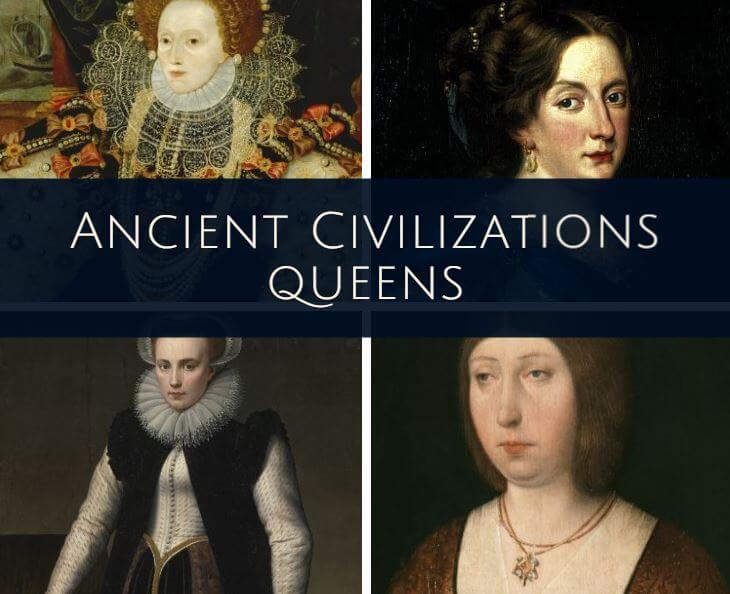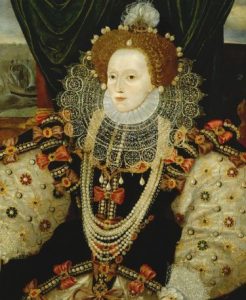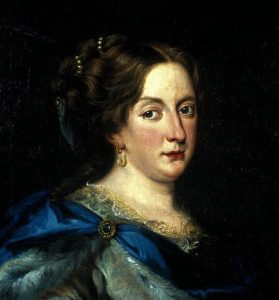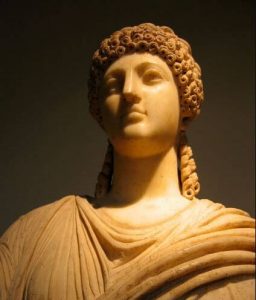Here’s a list of our 12 favorite queens of the ancient civilizations, and a brief description of their lives and history.

1. Isabella I of Castile
Contents
Isabella I of Castile (Madrigal de las Altas Torres, April 22, 1451 – Medina del Campo, November 26, 1504) was the Queen of Castile from 1474 to 1504, the Queen Consort of Sicily from 1469 and the Queen Consort of Aragon from 1479.
From the age of three, Isabella had been engaged to Ferdinand, the son of John II of Aragon.
However, Henry IV broke this arrangement off six years later, promising her to Prince Charles of Viana. This marriage did not come to fruition however due to fierce opposition from John II of Aragon. Henry IV’s attempts to marry her to King Alfonso V of Portugal, Isabella’s second cousin who was also 20 years her senior, were also unsuccessful. They met in 1464 in the Monastery of Guadalupe, but she rejected him due to the age difference.
Later, when she was 16, Isabella was engaged to Don Pedro Girón, the Master of the Order of Calatrava and Don Juan Pacheco’s brother, and it’s said that Isabella begged God for her to not marry the 43-year-old. Don Pedro died from appendicitis while making the journey to meet his fiancée.
On September 18, 1468, Isabella was proclaimed the Princess of Asturias in the Treaty of the Bulls of Guisando. Henry IV re-established the ties between Isabella and King Alfonso V of Portugal as it had been agreed in the Treaty of the Bulls of Guisando that Isabella’s marriage was to be held with the approval of the Castilian monarch. Following Isabella’s refusal, the king tried to marry her to the Duke of Guyenne, Louis XI of France’s brother. Meanwhile, John II of Aragon tried to negotiate the marriage between his son Ferdinand and Isabella in secret. Isabella and her advisors considered him to be the best candidate for marriage. The marriage led to a confrontation between Isabella and her half-brother, who stalled the papal bull of dispensation for kinship. Finally, and after the archbishop of Toledo’s mediation, on December 1, 1471, Pope Sixtus IV eliminated any doubts of the marriage’s canonical legality through the Bull of Simancas, which dispensed of Isabella and Ferdinand’s kinship.
Isabella came to the throne after winning the War of the Castilian Succession (1475-1480) against the supporters of her niece Joanna.

Isabella was proclaimed the Queen of Castile on December 13, 1474, in Segovia, on the basis of the Treaty of the Bulls of Guisando
She was a woman of great character and with much self-determination. She was strict with her children, but also a good mother, making them understand that they had obligations because of their rank as the children of royalty and that they had to sacrifice a lot as a result.
She had faith in Christopher Columbus’s projects in spite of the Court and scientists’ many criticisms and adverse political reactions; a legend says that the journey that led to the discovery of America was financed with her jewels. In reality, it was a group of merchants, the same who had financed Ferdinand of Aragon’s trip to marry her. Events that were massively important to the kingdom’s future took place during her shared reign with Ferdinand, such as the establishment of the Tribunal of the Holy Office of the Inquisition (1480), the creation of the Holy Brotherhood, the incorporation of the Nasrid Kingdom of Granada, as well as the religious unification of the Spanish Crown, based on the forced conversion of Jews under penalty of exile (Alhambra Decree, 1492), and later the Muslims. Finally, the annexation of Navarre in 1512, (the queen was dead by this point) signified the beginning of the future Kingdom of Spain.
She depended on the service of Gonzalo Fernández de Córdoba (the Great Captain) in her military campaigns. He participated in the conquest of Granada (1492), in the first two Italian Wars and in capturing Kefalonia (1500).
2. Cleopatra

Cleopatra VII Philopator, or simply Cleopatra (Greek: Κλεοπάτρα Φιλοπάτωρ), was the last Ptolemaic dynasty (also known as the Lagids) queen of ancient Egypt. This dynasty was created by Ptolemy I Soter, a general of Alexander the Great’s, and this was also the end of the so-called Hellenistic Period of Egypt.
Cleopatra was born in around 69 BC, and died in 30 BC. She was the daughter of Cleopatra V Tryphaena and Ptolemy XII Auletes, from whom she inherited the throne in 51 BC, when she was around 18, along with her brother Ptolemy XIII, who was only 12 years old, and who would also be her husband (a frequent occurrence in Ptolemaic royal marriages).
3. Elizabeth I of England
Elizabeth I, often known as the Virgin Queen, Gloriana or the Good Queen Bess, (Greenwich, September 7, 1533 – Richmond, March 24, 1603) was the Queen of England and Ireland from November 17, 1558, until the day she died. Elizabeth was the fifth and final Tudor Dynasty monarch.
The daughter of Henry VIII, she was born a princess, but her mother, Anne Boleyn, was executed when she was three years old. After this, Elizabeth was declared an illegitimate daughter. However, after the death of her half-brothers, Edward VI and Mary I, Elizabeth assumed the throne.
One of the first steps she took was to establish a Protestant church independent of Rome, which later evolved into the present day Church of England, and became the highest authority in the land.
Elizabeth was expected to get married, but despite several requests from Parliament, she never did. The reasons for this are not known and have been widely debated. As Elizabeth grew older, her virginity made her famous, and a cult grew up around her, celebrating her in portraits, parades and contemporary literature.

The queen took over a country divided by religious issues in the second half of the 16th century. During her reign, England was in a period of great cultural splendor, with figures like William Shakespeare and Christopher Marlowe. There were also important characters like Francis Drake and John Hawkins. Relations between her and Philip II of Spain were frosty, and she fought a war against him that economically ruined both countries. Her reign of 44 years and 127 days was the fourth longest in English history, behind those of Victoria I, George III, Elizabeth II and Edward III.
4. Marie Antoinette
Maria Antonia Josepha Johanna (Vienna, November 2, 1755 – Paris, October 16, 1793), better known as Marie Antoinette of Austria, was the Royal Princess of Hungary and Bohemia, Archduchess of Austria, Queen Consort of France and Navarre (1774-1791) and later the Queen of the French (1791 – 1792) through her marriage to Louis XVI.
5. Catherine the Great
Catherine II of Russia, dubbed the Great (Ekaterina Alekseyevna, in Russian: Екатерина Великая), was born in Szczecin (Stettin), Pomerania, [1] modern-day Poland, on May 2, 1729, and died in St. Petersburg on November 17, 1796, according to the Gregorian calendar. She reigned as the Empress of Russia for 34 years, from June 28, 1762, up until her death.
6. Elizabeth Báthory
Elizabeth Báthory wasn’t a queen, but she’s included because she’s in the series of photographs and due to her unusual story.
Many times, reality is stranger than fiction and gives us characters that seem to be straight out of a horror film. In cinema, vampires are a favorite among fans, but in reality characters like this are often just sociopaths or psychopaths. But did she really have a vampire and serial killer’s nature?
Her family was one of the most powerful and influential families in the Balkans, which included a cardinal, a princess and the Hungarian prime minister (her father). Elizabeth Báthory was born in 1560 and likely had ties to Vlad the Impaler’s family, which was useful to her as he had been crowned in Wallachia. Some texts reveal that Elizabeth Báthory suffered from severe seizures as a child that were caused by a disease unknown at the time. Many historians think that this disease was a kind of anemia aggravated by some form of mental illness. Others attributed it to other factors such as epilepsy, or illnesses that cannot be properly explained even today.

Elizabeth Báthory had a nomadic childhood due to the empire’s continuous struggles against Persian tribes and her forced marriage to the Hungarian Count Ferenc Nádasdy at the young age of 15. After these events, the count adopted the Báthory surname and as a result, Elizabeth kept her name and crown. As the story tells us, Elizabeth and the Count were not the happy couple that her father had expected them to be, as they had intense fights that often caused them to fall out of favor with their subjects. It is known that the couple lived in Čachtice Castle in Nyitra, Hungary.
Elizabeth Báthory, like her predecessors, belonged to a Hungarian occult order, which she was gradually led into by one of her servants named Dhorka, who was wicked as a witch. Several letters that link this order to the Order of the Dragon have been found in the castle, the same order that led Vlad the Impaler to the dark arts. By spending long hours with her servant and guide Dhorka, she quickly got involved in the occult and an unbelievable and macabre sadism awoke inside her. The long hours and days of her husband’s absence led the countess to the extreme, taking occasional young lovers. It’s known that Elizabeth Báthory had a daughter with some of them at the age of 15, but little is known about her.
Like Cleopatra, Elizabeth Báthory was obsessed with her physical appearance and was incredibly vain; seeing her skin grow old and not feeling pretty led her more than once to conducting rejuvenation rituals. So, when she found a victim for her sinister rituals, Elizabeth Báthory bathed in their blood, believing it to be a potential elixir of youth that would return life to her skin.
However, the biggest trigger that threw her into abominable satanic rituals was the death of her husband in 1600. After this, Elizabeth Báthory had free rein to commit atrocities. The first thing she did was kill her mother-in-law by hanging her from a butcher’s hook in the castle’s kitchen. In many texts sent to the royal guard, it was made to appear that she had sent her to another country to cover up her murder. After this, she decided to torture all the castle’s servants in relentless sadistic rituals. Elizabeth Báthory had sex with both men and women, ending in bloodthirsty torture.
The second on her list was a maid, whose hair she pulled extremely hard while combing it, and later she beat and bloodied her victim. Elizabeth Báthory thought that by taking the victim’s blood and covering her skin with it that it would rejuvenate her. Shortly after, she called her two favorite servants and ordered them to undress the maid and take her to her bath. When she was in it, she decided to have sex with her and inflict several wounds on the young woman’s body to exsanguinate her and drain her of her vital essence. It was here that Elizabeth Báthory, after seeing the dead maid, decided to take a good bath in the blood, believing that she would become stronger.
After this and a huge increase in her wickedness and the magnitude of her orders, Elizabeth Báthory sent her servants once to a week to bring a youth from the city to use in their macabre rituals; she asked for these young people to be virgins since it was said that rejuvenating blood was retained in sexual purity. Telling them that they’d be working in the castle with the countess and earning gold coins, the butler and Dhorka provided her with beautiful maidens and handsome knights for several years.
Her bloodlust increased with every passing day and servants no longer satisfied her; her actions became more and more atrocious every day, and her thirst for blood was so intense that she decided to take young members of the royal nobility for her rituals. Her obsession ended up blinding her and she became careless. Over the course of several years – almost 10 – and having committed so many atrocious acts against the nobility, this same oversight led to rumors and suspicions throughout the court that reached the emperor’s ears. The following month, the same emperor asked Count Cuyorgy Thurzo to launch an investigation to get to the bottom of everything.
As early as December 30, 1610, the Count ordered an expedition to Čachtice Castle to collect evidence. One of the guards sent to the castle to enter its dark walls saw a horrific sight in the courtyard, as in their search they found a servant bleeding out in the central well. In the castle dungeon, they also found more than 50 corpses of young women with their skin almost completely peeled off. Many of them had also been tortured but were still alive, with many of them in an Iron Maiden, a coffin with metallic prongs on the lid and perforations outside to let the blood out.
After these horrifying massacres were proven, the Count decided to sentence her to death in a trial held on March 13, 1611, in which four of her most loyal assistants were also convicted. This judgement was written and drafted by a Hungarian writer, and it remains in the Hungarian National Museum today as part of human heritage, which was certainly rather bloodthirsty in those days.
7. Christina, Queen of Sweden
Cristina (*Stockholm, December 8, 1626 – † Rome, April 19, 1689) was the Queen of Sweden (1632-1654) and Duchess of Bremen-Verden (1648-1654). She was the daughter of Gustav II Adolf and Maria Eleonora of Brandenburg, and a protector of the arts and patrons. She abdicated the Swedish throne in 1654, and although she was born Protestant, she converted to Catholicism the same year. She died in Rome aged 63.

At the age of 16, Christina began attending Council of the Realm meetings, flawlessly demonstrating her knowledge of the kingdom’s laws and administration.
At the age of 18, she came of age and assumed her position as sovereign, gradually replacing Lord High Chancellor Oxenstierna in his duties. In 1645 she actively participated in the peace treaty with Denmark (Treaty of Brömsebro), which was favorable to Sweden.
In 1648 Sweden signed the Peace of Westphalia, ending the Thirty Years War, and leaving the kingdom in an unparalleled position of supremacy in the Baltic. Christina and Lord High Chancellor Oxenstierna had differences in how the agreements should be carried out, with the queen finally imposing her opinion.
On 17 October 1650, Christina was crowned in Stockholm. There were many celebrations, lasting for weeks. According to custom, she named her cousin Carl Gustav as her successor.
The Swedish ruler had begun to develop the kingdom’s cultural life some years earlier, which had been damaged through religious conflicts, including the destruction of works considered Catholic. She adopted the motto “Wisdom is the pillar of the kingdom” (Columna regni sapientia).
The fame of the protector of culture began to expand and several well-known European intellectuals became interested in her projects. Christina saw the possibility of luring them to her court through patronage. In this way, the French intellectual René Descartes, with whom Christina had corresponded for years, arrived in Stockholm in 1649, and died of illness there five months later. In 1652 the artist Sébastien Bourdon arrived, working as a court painter for two years until the queen’s abdication and he had to return to his country.
Cristina valued painting and without hesitation gave King Philip IV of Spain the two main treasures of her gallery, Dürer’s works Adam and Eve, which can be seen in the Prado Museum today.
During her time in Rome, the Queen’s projects led to a renewed vigor in cultural activities, which began to bring artists, scientists, and intellectuals together in her residence. She gave them a basic structure through academies where they could discuss and create works. The most outstanding individuals were given a stipend by the Queen and in some cases a pension.
The Queen was interested in archeology, and despite her limited income, she financed excavations. She compiled an excellent collection of ancient sculptures, such as a group of Muses that would later be acquired by Philip V of Spain. These Muses, currently in the Prado Museum, preside over its new oval hall, remodeled by Rafael Moneo.
She also built an observatory in her palace, hired two astronomers, and spent hours looking at the heavens.
These academies attracted scientists like the physiologist Giovanni Alfonso Borelli, persecuted for his sympathies with Galileo’s ideas. They also attracted noteworthy musicians like Bernardo Pasquini, Alessandro Scarlatti, Arcangelo Corelli and Alessandro Stradella, and poets like Carlo Alessandro Guidi and Vincenzo da Filicaja.
Her friendship with the sculptor Gian Lorenzo Bernini is noteworthy, having often visited him in his workshop and having protected him when he lost Pope Innocent X’s favor.
She also busied herself with decorating her palace with collections of paintings, sculptures, tapestries and books for her exceptionally rich library.
As a freethinker, Christina also opposed religious persecution, doing so by publishing a manifesto in 1686 where she defended the Jews of Rome. She also strongly criticized Louis XIV for persecuting the Huguenots in 1685 and conflicted with Pope Innocent XI because of his aim of eliminating diplomatic immunity and the right to asylum in Rome in 1685.
8. Boudica
Boudica was an Icenian warrior queen who led several British tribes, including the neighboring Trinovantes, during the largest uprising against Roman occupation between 60 and 61 AD, during the reign of Emperor Nero. These incidents were mainly recounted by two historians, Tacitus (in his Annals and in The Life of Agricola) and Cassius Dio (in Roman History).
Her name meant ‘victory’, and she was also known as Budica, Buduica, Bonduca, or by the Latinized name Boadicea.
9. Alexandra Feodorovna
Alexandra Feodorovna (born Alix Viktoria Helena Luise Beatrice of Hesse and by Rhine), (*Darmstadt, June 6, 1872 – † Yekaterinburg, July 17, 1918). She was the last Empress of Russia prior to the October Revolution.

Following the courtship between her sister Elisabeth Feodorovna and the Grand Duke Sergei Alexandrovich of Russia, Alexandra met the future Nicolas II, with whom she established a solid and intense relationship that came to a head with their marriage on November 26, 1894, shortly after the death of Tsar Alexander III. Russian commoners thought the new Empress following a coffin to be a bad omen.
Nicholas II referred to Alix as Sunny, and they both professed a true and selfless love. The proof of this is in the mass of correspondence that would survive the Romanovs.
Their residence, among others, was the palace constructed by Catherine the Great, Tsarskoye Selo, 20 km to the south of Saint Petersburg.
The couple had five children: Olga (1895-1918), Tatiana (1897-1918), Maria (1899-1918), Anastasia (1901-1918), and Tsarevich Alexei (1904-1918).
As her husband marched forwards during World War I, she took over effective Russian governance on her own. She could not cope with the burgeoning social and cultural crises, her ministerial appointments were unsuccessful, and being German made her unpopular. She strongly opposed the idea of providing the country with constitutional rule and faced the waves of Bolshevism.
When the Russian Revolution took place in February 1917, the Duma made Nicholas II abdicate in defiance of Alix. She was confined with her husband and children to Alexander’s palace in Tsarskoye Selo, where they all left for Tobolsk, Siberia, in August that year.
In the spring of the following year, they were transferred to the city of Yekaterinburg, where they were executed in the basement of Ipatiev House in the early hours of July 17, 1918.
After the fall of the Soviet regime in the 1990s, her remains were exhumed and buried beside her husband and three daughters in the Saints Peter and Paul Cathedral in St. Petersburg. She was canonized as a martyr by the Orthodox Church.
10. Olympias
Olympias (375 BC – 315 BC) was the chief wife of King Philip II of Macedon and the mother of Alexander the Great. She was a daughter of Neoptolemus I of Epirus, in the northwest of modern-day Greece.

Many writings on Olympias’ life do not remain, and historians have had to sift through the few fragments that have come into their hands. However, there was a legend spread by her enemies, especially by the greatest of them all: Cassander. It is said that she was a violent, neurotic and superstitious woman. Several well-known people at the time were assassinated under her orders; Olympias did exactly what other kings of her time did, i.e. try to eliminate potential rivals.
Her maiden name was Polyxena, in honor of Priam’s daughter of the same name who was sacrificed in the tomb of Achilles. She changed her name to Myrtale when she married Philip, and later changed it to Olympias, in memory of the victory that Philip had won there on the very day of his son Alexander’s birth. Over the years, she changed her name once again to Stratonice, in honor of the victory won by her grandson Alexander IV against his rival Eurydice (who was allied with Cassander of Macedonia’s successors).
11. Agrippina
Julia Vipsania Agrippina (possibly born in Oppidum Ubiorum, AD 15 – † 59 AD), better known as Agrippina the Younger to distinguish her from her mother, was the eldest daughter of Germanicus and Agrippina the Elder, and the great-granddaughter of both Antony and Octavia, Augustus’ sister. She was also Caligula’s sister, Claudius’ wife and Nero’s mother.

In 28 AD, aged just 13, she got married for the first time to the Roman consul Ahenobarbus. It was he who said of his future son that “only a monster can emerge from the union between me and Agrippina.” And from this union, Lucius Domitius Ahenobarbus was born, better known as Nero.
In January 40 AD, at the age of 25 years and after 12 years of marriage, Agrippina was widowed for the first time.
When her brother Caligula became emperor, she and her two sisters began to enjoy certain privileges only available to the imperial family. Even though she was married to Ahenobarbus, Agrippina had sexual relations with her brother, as did her sisters, and she prostituted herself out to members of the court, like her sisters Drusilla and Livilla, who were also married.
The privileges enjoyed by Agrippina began to disappear after the death of Caligula’s favorite sister, Drusilla. After this, the emperor began to suffer from a mental illness that caused Agrippina to lose favor with her brother.
Ambitious like her mother, Agrippina wanted to continue having the privileges that her brother had stopped. It was for this reason that her lover Lentulus, her little sister Livilla, and their joint lover, their widowed brother-in-law Lepidus, made a plan to get their way of life back. Caligula discovered the plot in time and ordered the death of Lepidus and the exile of his two sisters in the previous trial.
Separated from her son, who remained in Rome in the care of his paternal aunt, Agrippina began her exile with the public humiliation of carrying the ashes of one of her lovers. This was how she set off for the isle of Ponza.
The murder of Caligula and the appointment of his uncle Claudius as emperor led to Agrippina and her sister’s return to Rome. After reuniting with her son, Agrippina married Gaius Sallustius Crispus Passienus, her former brother-in-law and consul between 27 and 44 AD. When he died, before 47 AD, it was rumored that he had been poisoned.
Agrippina was having an increasingly more intimate relationship with her uncle, the emperor. After discovering that his wife Messalina, the mother of his son and daughter, had been unfaithful to him, he decided to execute her and marry his niece, even though marriage between uncles and nieces was illegal and incestuous. The issue was resolved through a special Senatorial agreement.
When she was 34 (40 AD) she married for the third and last time, this time to her uncle, the Emperor Claudius. She also advised her son to marry his new step-sister, Octavia. Having obtained the title of empress and Augusta, the first since Livia, and having obtained extraordinary honors and privileges, Agrippina convinced her husband to make Nero, her son, his heir instead of his biological son. And that was that. Having achieved her purpose, it is said that she ordered her husband to be poisoned using mushrooms, although there is no historical evidence of this.
When Nero was appointed emperor at the age of 16, Agrippina used her son, who she reportedly had sex with, to rule Rome. Suetonius explains that Nero supported his mother less and less, threatening to abdicate and exile her to Rhodes. This was due in part to her getting closer to her overlooked son-in-law Britannicus. After Britannicus was murdered during a banquet, her influence notably diminished and she was asked to leave the imperial palace.
Poppaea Sabina’s arrival at the imperial court as her son’s partner marked the end of Agrippina. Poppaea soon realized that her future mother-in-law was manipulating her son for her needs. Knowing that she was not well-liked by her, Poppaea persuaded Nero to kill his mother.
First, he tried to poison her several times. Then he planned to demolish her room while she was sleeping inside, but she discovered the plan and became enraged. Taking advantage of the bad relationship between him and his mother, Nero invited her to a boat to reconcile. Having accepted, she did not realize that her son’s intention was to sink it with her inside. Again Agrippina discovered the plans and fled. Desperate, the Emperor accused his mother of being a member of a fictitious conspiracy and she was executed, although the details of this planned crime are unclear.
Her death fulfilled a Chaldean astrologer prophecy which said that when Agrippina asked whether her son would be king, they replied: “he will be king, but he will kill his mother”. After hearing these words, she replied “Occidat, dum imperet!” (Kill me as long as I reign!).
Agrippina’s murder was ever present in her son’s mind, who claimed to see her spirit as well as Furies waving vengeful whips and burning torches.
12. Eleanor of Aquitaine
Eleanor of Aquitaine (Aliénor d’Aquitaine or Éléonore de Guyenne in French) (Poitiers, 1122 – Fontevraud-l’Abbaye, 1 April 1204) was the Duchess of Aquitaine and Guyenne and the Countess of Gascony in her own right, as well as Queen Consort of France and England.
